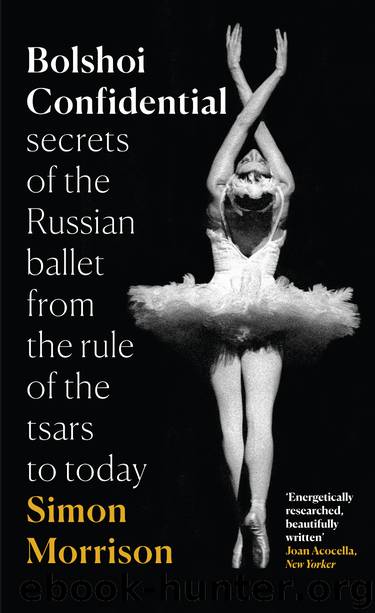Bolshoi Confidential by Simon Morrison

Author:Simon Morrison [Morrison, Simon]
Language: eng
Format: epub
Publisher: HarperCollinsPublishers
Published: 2016-09-18T16:00:00+00:00
. 6 .
CENSORSHIP
BY THE TIME STALIN had beaten back his rivals to consolidate power, there was as much real political drama at the Bolshoi as anything imagined in ballet or opera. Stalin delivered speeches onstage extolling the achievements of the Soviet people past, present, and future. The applause and hurrahs would crescendo, ebb, then begin anew. On one occasion the uniformed, pockmarked ruler poured himself a glass of cognac at the podium as a toast to the working class. More clapping. Another orgy of adulation ended with Stalin wiping the side of his face, slicing the top of his throat with the fingers and palm of his right hand, waving off the crowd in feigned humility, and finally saying, irritably, in his nasal, Georgian-accented voice, “Enough.”1
The Bolshoi hosted several All-Russian Congresses of Soviets and several more All-Soviet Union Congresses. The very establishment of the USSR was celebrated on its stage with banners and speeches; the first Soviet constitutions were ratified there. Lenin had spoken dozens of times at the Bolshoi, as had members of the executive committee charged with determining the path to socialism and beyond to communism. The Communist International met in the theater, likewise the heads of the NKVD (Narodnïy komissariat vnutrennikh del), the People’s Commissariat for Internal Affairs, which was established in 1934 as the replacement to the Cheka. Under the control of the Politburo, the inner circle of Stalin’s inner circle, the NKVD targeted communist officials, members of the armed services, rank-and-file bureaucrats, perceived saboteurs, traitors, anyone among the intelligentsia suspected of resistance or subversion, and artists without the stature to make them indispensable to the regime. Those citizens of the police state whose names landed on arrest orders were taken into custody (often at night), tried publicly or secretly, and imprisoned in the labor camps that supported the Soviet economy. Or they were simply executed.
Stalin dreamed, as had the Russian tsars before him, of leading the huge swath of the planet under his control to dominate the rest and so demanded superhuman agricultural and industrial production. The Soviet Union would grow wheat and forge steel for the world while also exporting its values through the Communist International as well as more discreet espionage organizations, including one dedicated to the cause of cultural exchange. Among the consequences of Stalin’s aims were a famine in Ukraine that killed millions, the construction of a vast labor-camp system known as the Gulag, and a literal decimation (it was reduced to a tenth of its size) of the Red Army officer corps that left the nation far more vulnerable to Nazi invasion. The trauma of Stalin’s reign has not been much reckoned with in Russia, and the might and power he symbolized retains its noxious nationalist pull.
Long before these terrible events, long before the Imperial Theaters in St. Petersburg and Moscow came to be managed by a single administration charged with “bringing theatrical performances to perfection,” the Bolshoi fell under the control of the military governor general of Moscow.2 Under Stalin, the Bolshoi was militarized again—both the building itself and the performances within.
Download
This site does not store any files on its server. We only index and link to content provided by other sites. Please contact the content providers to delete copyright contents if any and email us, we'll remove relevant links or contents immediately.
| Africa | Americas |
| Arctic & Antarctica | Asia |
| Australia & Oceania | Europe |
| Middle East | Russia |
| United States | World |
| Ancient Civilizations | Military |
| Historical Study & Educational Resources |
Red Famine: Stalin's War on Ukraine by Anne Applebaum(2817)
Chernobyl by Serhii Plokhy(2441)
Midnight in Chernobyl by Adam Higginbotham(2392)
The House of Government by Slezkine Yuri(2106)
Midnight in Chernobyl: The Untold Story of the World's Greatest Nuclear Disaster by Adam Higginbotham(2081)
Red Shambhala by Andrei Znamenski(2074)
The Gulag Archipelago (Vintage Classics) by Aleksandr Solzhenitsyn(1987)
All the Kremlin's Men by Mikhail Zygar(1963)
From Cold War to Hot Peace by Michael McFaul(1942)
Red Notice by Bill Browder(1935)
Putin's Labyrinth(1903)
The Future Is History by Masha Gessen(1824)
From Russia with Lunch by David Smiedt(1800)
A People's Tragedy by Orlando Figes(1770)
The Romanovs by Simon Sebag Montefiore(1724)
How to Tame a Fox (and Build a Dog): Visionary Scientists and a Siberian Tale of Jump-Started Evolution by Lee Alan Dugatkin & Lyudmila Trut(1682)
Putin's Labyrinth: Spies, Murder, and the Dark Heart of the New Russia(1666)
The Lost Spy by Andrew Meier(1636)
Art and Revolution by John Berger(1608)
